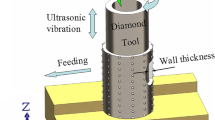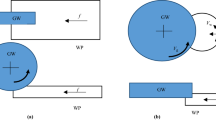Abstract
Subsurface damage (SSD) induced by the rotary ultrasonic face machining (RUFM) considerably influences the technological application of the optical components. However, currently, there is no method to detect the depth of SSD in real time. For the purpose of precise and nondestructive evaluation of the SSD depth generated in RUFM processes, a predictive model was developed by applying the indentation fracture mechanics of brittle material. This was the first time that the correlation between the measured cutting force and SSD depth had been established. It was found that the SSD depth was directly proportional to the exponent of the measured cutting force (namely d SSD = γF c χ). Using this model, the depth of SSD could be predicted rapidly and precisely in the RUFM of optical glass even in real time using the measuring cutting force. Subsequently, this method was verified by conducting RUFM tests on K9 glass specimens with Sauer Ultrasonic 50. Meanwhile, the cutting force and SSD depth were compared experimentally between RUFM and conventional grinding (CG) process, indicating that RUFM is a beneficial manufacturing method for optical glass with reduced cutting force and SSD depth.
Similar content being viewed by others
References
Choi JP, Jeon BH, Kim BH (2007) Chemical-assisted ultrasonic machining of glass. J Mater Process Technol 191(1–3):153–156. doi:10.1016/j.jmatprotec.2007.03.017
Zhao CY, Gong H, Fang FZ (2013) Experimental study on the cutting force difference between rotary ultrasonic machining and conventional diamond grinding of K9 glass. Mach Sci Technol 17(1):129–144. doi:10.1007/s00170-014-6216-6
Gu WB, Yao ZQ, Liang XG (2011) Material removal of optical glass BK7 during single and double scratch tests. Wear 270(3–4):241–246. doi:10.1016/j.wear.2010.10.064
Fang FZ, Chen LJ (2000) Ultra-precision cutting for ZKN7 glass. CIRP Ann Manuf Technol 49(1):17–20. doi:10.1016/S0007-8506(07)62887-X
Gu WB, Yao ZQ, Li HL (2011) Investigation of grinding modes in horizontal surface grinding of optical glass BK7. J Mater Process Technol 211(10):1629–1636. doi:10.1016/j.jmatprotec.2011.05. 006
Arif M, Rahman M, San WY (2011) Analytical model to determine the critical feed per edge for ductile-brittle transition in milling process of brittle materials. Int J Mach Tools Manuf 51(3):170–181. doi:10.1016/j.ijmachtools.2010.12.003
Belkhir N, Bouzid D, Herold V (2009) Surface behavior during abrasive grain action in the glass lapping process. Appl Surf Sci 255(18):7951–7958. doi:10.1016/j.apsusc.2009.04.178
Kumar J (2013) Ultrasonic machining—a comprehensive review. Mach Sci Technol 17(3):325–379. doi:10.1080/10910344.2013.806093
Cong WL, Pei ZJ, Feng Q, Deines TW, Treadwell C (2012) Rotary ultrasonic machining of CFRP: a comparison with twist drilling. J Reinf Plast Compos 31(5):313–321. doi:10.1177/073168441 1427419
Li ZC, Cai LW, Pei ZJ (2006) Edge-chipping reduction in rotary ultrasonic machining of ceramics: finite element analysis and experimental verification. Int J Mach Tools Manuf 46(12–13):1469–1477. doi:10.1016/j.ijmachtools.2005.09.002
Zhang CL, Zhang JF, Feng PF (2013) Mathematical model for cutting force in rotary ultrasonic face milling of brittle materials. Int J Adv Manuf Technol 69(1–4):161–170. doi:10.1007/s00170-013-5004-z
Pei ZJ, Prabhakar D, Ferreira PM, Haselkorn M (1995) A mechanistic approach to the prediction of material removal rates in rotary ultrasonic machining. J Manuf Sci Eng 117(2):142–151. doi:10.1115/1.2803288
Zhang CL, Feng PF, Wu ZJ, Yu DW (2011) An experimental study on processing performance of rotary ultrasonic drilling of K9 glass. Adv Mater Res 230–232:221–225. doi:10.4028/www.scientific.net/AMR.230-232.221
Li ZC, Jiao Y, Deines TW, Pei ZJ (2005) Rotary ultrasonic machining of ceramic matrix composites: feasibility study and designed experiments. Int J Mach Tools Manuf 45(12–3):1402–1411. doi:10.1016/j.ijmachtools.2005.01.034
Churi NJ, Pei ZJ, Treadwell C (2007) Rotary ultrasonic machining of titanium alloy (Ti-6Al-4V): effects of tool variables. Int J Precis Eng 1(1):85–96
Cong WL, Pei ZJ, Sun X, Zhang CL (2014) Rotary ultrasonic machining of CFRP: a mechanistic predictive model for cutting force. Ultrasonics 54(2):663–675. doi:10.1016/j.ultras.2013.09.005
Zhang CL, Cong WL, Feng PF, Pei ZJ (2013) Rotary ultrasonic machining of optical K9 glass using compressed air as coolant: a feasibility study. Proc Inst Mech Eng B J Eng 228(4):504–514. doi:10.1177/095440541350 6195
Agarwal S, Rao PV (2008) Experimental investigation of surface/subsurface damage formation and material removal mechanisms in SiC grinding. Int J Mach Tools Manuf 48(6):698–710. doi:10.1016/j.ijmachtools.2007.10.013
Miller PE, Suratwala TI, Wong LL, Feit MD (2005) The distribution of subsurface damage in fused silica. Proc SPIE 5991:1–25. doi:10.1117/12.638821
Wang J, Li Y (2011) Evaluating subsurface damage in optical glasses. J Eur Opt Soc Rapid 6:11001
Wang Z, Wu Y, Dai YF, Li SY (2008) Subsurface damage distribution in the lapping process. Appl Opt 47(10):1417–1426. doi:10.1364/AO.47.001417
Wang Z (2008) Study on the detection and control techniques of subsurface damage in optical fabrication. Ph. D. thesis, National University of Defense Technology
Ellingson JA, Todd JA, Sun J (2001) Optical method and apparatus for detection of defects and microstructural changes in ceramics and ceramic coatings. US Patent 6285449:B1
Meeder M, Mauret T, Booij S, Braat J, Fahnle O (2003) Optimization of polishing processes by using iTIRM for in-situ monitoring of surface quality. Proc SPIE 5180:40–46. doi:10.1117/12.503679
Yoshikawa M, Zhang B, Tokura H (1987) Observations of ceramics surface cracks by newly proposed methods. J Ceram Soc Jpn 95:961–969
Affatigato M, Osborne DH, Haglund RF (1996) Effect of surface roughness on the acid etching of amorphous silica. J Am Ceram Soc 79:688–694
Hed PP, Edwards DF (1987) Relationship between subsurface damage depth and surface roughness during grinding of optical glass with diamond tools. Appl Opt 26:2491
Neauport J, Ambard C, Cormont P, Darbois N, Destribats J, Luitot C, Rondeau O (2009) Subsurface damage measurement of ground fused silica parts by HF etching techniques. Opt Express 17:20448–20456
Lambropoulos JC, Jacobs SD, Ruckman J (1999) Material removal mechanisms from grinding to polishing. Ceram Trans 102:113–128
Lv DX, Huang YH, Tang YJ, Wang HX (2013) Relationship between subsurface damage and surface roughness of glass BK7 in rotary ultrasonic machining and conventional grinding processes. Int J Adv Manuf Technol 67(1–4):613–622. doi:10.1007/s00170-012-4509-1
Liu DF, Cong WL, Pei ZJ, Tang Y (2012) A cutting force model for rotary ultrasonic machining of brittle materials. Int J Mach Tools Manuf 52(1):77–84. doi:10.1016/j.ijmachtools.2011.09.006
Pei ZJ, Ferreira PM (1998) Modeling of ductile-mode material removal in rotary ultrasonic machining. Int J Adv Manuf Technol 38(10–11):1399–1418. doi:10.1016/S0890-6955(98)00007-8
Zarepour H, Yeo SH (2012) Predictive modeling of material removal modes in micro ultrasonic machining. Int J Mach Tools Manuf 62:13–23. doi:10.1016/j.ijmachtools.2012.06.005
Zhou XG (2011) Study on the machining mechanisms and surface quality in ultrasonic vibration grinding of silicon nitride ceramics. Master thesis, Harbin Institute of Technology
Astashev VK, Babitsky VI (2007) Ultrasonic processes and machines: dynamics, control and applications. Springer, Berlin, pp 208–209
Xiao X, Zheng K, Liao W (2014) Theoretical model for cutting force in rotary ultrasonic milling of dental zirconia ceramics. Int J Adv Manuf Technol 75(9–12):1263–1277. doi:10.1007/s00170-014-6216-6
Author information
Authors and Affiliations
Corresponding author
Rights and permissions
About this article
Cite this article
Wang, J., Zhang, C., Feng, P. et al. A model for prediction of subsurface damage in rotary ultrasonic face milling of optical K9 glass. Int J Adv Manuf Technol 83, 347–355 (2016). https://doi.org/10.1007/s00170-015-7567-3
Received:
Accepted:
Published:
Issue Date:
DOI: https://doi.org/10.1007/s00170-015-7567-3




